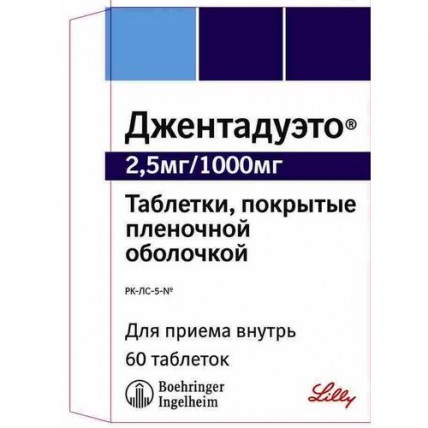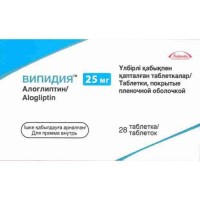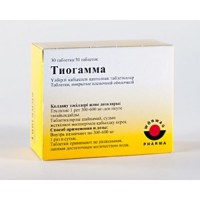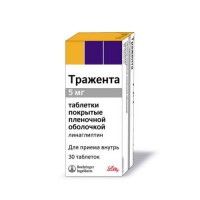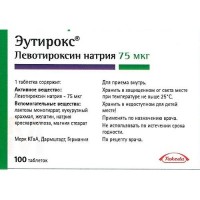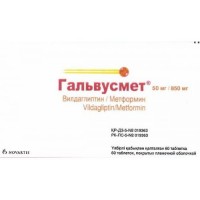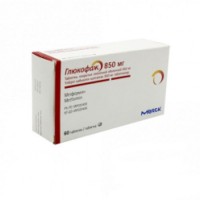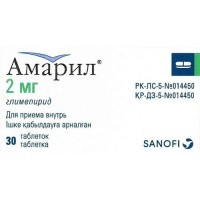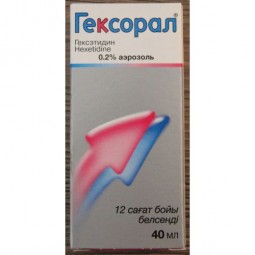Jentadueto® (Linagliptin/Metformin HCI) 2.5 mg/1000 mg (60 film-coated tablets)
- $167.20
Sku:
48ac0450fe15
Buy Jentadueto® (Linagliptin/Metformin HCI) 2.5 mg/1000 mg (60 film-coated tablets)
Release form: 1000mg film-coated tablets
Dose: 2.5 mg
Pack quantity: 60 pcs.
Manufacturer: Boehringer Ingelheim
INN: Metformin + Linagliptin
One tablet contains:
active substances: linagliptin 2.5 mg, metformin hydrochloride 850 mg or 1000 mg,
excipients: arginine, corn starch, copovidone, colloidal anhydrous silicon dioxide, magnesium stearate;
film sheath: titanium dioxide (E171), iron (III) oxide yellow (E172) (for a dosage of 2.5 mg / 850 mg), iron (III) oxide red (E172), propylene glycol, hypromellose 2910, talc.
Pharmacokinetics
Bioequivalence studies carried out in healthy volunteers have shown that JENTADUETO is bioequivalent to linagliptin and metformin hydrochloride used separately in combination therapy.
The use of the drug JENTADUETO 2.5 / 1000 mg with food does not lead to a change in the pharmacokinetic parameters of linagliptin. The area under the concentration-time curve (AUC) of metformin does not change, but the mean maximum serum concentration of metformin decreases by 18% when administered with food. The use of the drug on an empty stomach leads to a delay in reaching the maximum concentration of metformin in serum by 2 hours. These changes are clinically insignificant.
Below are data reflecting the pharmacokinetic properties of the individual active components of the drug JENTADUETO.
Linagliptin
The pharmacokinetics of linagliptin have been well studied in healthy volunteers and patients with type 2 diabetes mellitus (type 2 diabetes). After taking linagliptin orally at a dose of 5 mg, the drug is rapidly absorbed, peak plasma concentrations (median Tmax) are reached after 1.5 hours. Plasma concentrations of linagliptin decrease in three phases. The terminal half-life is long (more than 100 hours), which is due to the intense, stable binding of linagliptin to DPP-4 and does not lead to drug accumulation. The effective half-life for the accumulation of linagliptin, determined after repeated administration of linagliptin at a dose of 5 mg, is approximately 12 hours. After a single dose of linagliptin at a dose of 5 mg, plasma concentrations at the stage of dynamic equilibrium are achieved after taking the third dose, while the AUC of linagliptin in plasma increases by about 33% compared to the first dose. The coefficients of variation for linagliptin AUC were small: 12.6% and 28.5%. The pharmacokinetics of linagliptin is nonlinear due to the concentration dependence of the binding of linagliptin to DPP-4. The total AUC of linagliptin in plasma increases in a less dose-dependent manner than the unbound AUC, which increases in a more dose-dependent manner. The pharmacokinetics of linagliptin in healthy people and in patients with type 2 diabetes mellitus are similar.
Absorption: The absolute bioavailability of linagliptin is approximately 30%. Taking linagliptin with food high in fat increases the time to reach maximum plasma concentration (Cmax) by 2 hours and leads to a decrease in Cmax by 15%, but does not affect AUC0-72h. There is no clinically significant change in Cmax and Tmax, therefore linagliptin can be used regardless of food intake.
Distribution: As a result of tissue binding, the average volume of distribution at the dynamic equilibrium stage after a single dose of 5 mg is approximately 1110 liters, indicating extensive tissue distribution. The binding of linagliptin to plasma proteins depends on the concentration of the drug and decreases by 99% at 1 nmol / L to 75-89% at ≥30 nmol / L, which reflects the saturation of the drug's bond with DPP-4 as the concentration of linagliptin increases. At high concentrations of linagliptin, when the binding to DPP-4 is completely saturated, 70-80% of linagliptin binds to other plasma proteins (not DPP-4), and 30-20% of the drug is in a free state.
Metabolism and excretion: After taking linagliptin at a dose of 10 mg, approximately 5% is excreted in the urine. Metabolism plays a minor role in the elimination of linagliptin. One major metabolite was identified without pharmacological activity and with a relative effect of 13.3% linagliptin in the dynamic equilibrium stage, therefore, it does not have an inhibitory effect of linagliptin on DPP-4 in plasma. Approximately 85% is excreted (with feces 80% and urine 5%) within 4 days after ingestion. Renal clearance in the dynamic equilibrium stage is approximately 70 ml / min.
Patients with impaired renal function: in the dynamic equilibrium stage in patients with mild renal impairment, the exposure profile of linagliptin is similar to that in healthy volunteers. In patients with moderate renal failure, there is a moderate increase in the exposure profile of approximately 1.7 times compared with the control group. The exposure profile in patients with type 2 diabetes mellitus and severe renal failure increased approximately 1.4-fold compared to patients with type 2 diabetes with normal renal function.
The measured AUC values of linagliptin in the dynamic equilibrium stage in patients with end-stage renal impairment indicate comparable drug exposure levels in patients with moderate or severe renal impairment. In addition, linagliptin is not excreted to a therapeutically significant extent by hemodialysis or peritoneal dialysis. In patients with any degree of impaired renal function, dose adjustment of linagliptin is not required, therefore, you can continue taking linagliptin in the form of one tablet at a daily dose of 5 mg, if JENTADUETO is canceled due to the presence of impaired renal function.
Patients with impaired liver function: in patients with impaired liver function of any degree (classes A, B and C according to the Child-Pugh classification), the average values of AUC and Cmax of linagliptin were similar to the control group after taking multiple doses of linagliptin 5 mg.
No dose adjustment is required depending on gender, body mass index (BMI), race, age of patients.
Metformin
Absorption: after taking metformin inside, Tmax is achieved after 2.5 hours. In healthy volunteers, the absolute bioavailability of metformin hydrochloride after oral administration in a dose of 500 mg or 850 mg is approximately 50-60%. After taking the drug inside, about 20-30% of the drug is not absorbed and excreted in the feces unchanged.
The absorption of metmorphine hydrochloride is saturated and incomplete, the pharmacokinetics of absorption is nonlinear. When the recommended doses of metformin hydrochloride are taken, steady-state plasma concentrations are achieved within 24-48 hours and are usually less than 1 μg / ml. In clinical studies, plasma levels of metformin hydrochloride Cmax did not exceed 5 μg / ml, even at maximum doses. Food intake reduces the absorption of metformin hydrochloride and slows it down somewhat. After using the drug at a dose of 850 mg with food, the Cmax readings are 40% lower, the AUC is 25% lower, and the Tmax increases by 35 minutes. The clinical significance of a decrease in these rates is unknown.
Distribution: the binding of metformin to plasma proteins is negligible. Metformin hydrochloride is distributed by erythrocytes. The maximum concentration of the drug in the blood is lower than in plasma and is reached approximately simultaneously. It is assumed that erythrocytes are an additional compartment for drug distribution. The average volume of distribution (Vd) varies from 63 to 276 liters.
Metabolism and excretion: metformin hydrochloride is excreted by the kidneys unchanged. In humans, drug metabolites have not been identified. The renal clearance of metformin hydrochloride exceeds 400 ml / min, which indicates the elimination of the drug by glomerular filtration and tubular secretion. After oral administration, the terminal half-life is approximately 6.5 hours.
In case of impaired renal function, the renal clearance of the drug decreases in proportion to creatinine clearance, therefore the half-life is lengthened, which leads to an increase in the level of metformin hydrochloride in plasma.
Pharmacodynamics
The drug JENTADUETO is a fixed combination of two glucose-lowering compounds - linagliptin and metformin hydrochloride, with a complementary mechanism of action to improve hypoglycemic control in the blood in patients with type 2 diabetes.
Linagliptin is an inhibitor of the DPP-4 (dipeptidyl peptidase 4) enzyme, which is involved in the inactivation of incretin hormones - glucagon-like peptide-1 (GLP-1) and glucose-dependent insulinotropic polypeptide (GIP). These hormones are rapidly destroyed by the DPP-4 enzyme. Both incretins are involved in the physiological regulation of glucose homeostasis. The basal level of incretin secretion during the day is low; it rises rapidly after eating. GLP-1 and GIP enhance the biosynthesis and secretion of insulin by pancreatic beta cells at normal and elevated blood glucose levels. In addition, GLP-1 reduces the secretion of glucagon by pancreatic alpha cells, which leads to a decrease in glucose production in the liver.
Linagliptin effectively and reversibly binds to DPP-4, which causes a steady increase in the level of incretins and maintains their activity for a long time. Linagliptin increases insulin secretion in a glucose-dependent manner and decreases glucagon secretion, improving glucose homeostasis. Linagliptin binds selectively to DPP-4, in vitro its selectivity exceeds the selectivity for DPP-8 or activity against DPP-9 by more than 10,000 times.
Metformin hydrochloride is a biguanide and has a hypoglycemic effect by lowering basal and postprandial plasma glucose levels. Metformin does not stimulate insulin secretion and therefore does not lead to hypoglycemia.
Metformin has 3 mechanisms of action:
- reducing the formation of glucose in the liver by inhibiting gluconeogenesis and glycogenolysis in muscles
- increasing peripheral glucose storage and glucose uptake by skeletal muscle by increasing insulin sensitivity
- slowing down the absorption of glucose in the intestine
Metformin hydrochloride stimulates intracellular synthesis glycogen by acting on glycogen synthetase.
Metformin hydrochloride increases the transport capacity of all known types of membrane glucose transporters.
Metformin hydrochloride, regardless of the effect on glycemia, has a beneficial effect on lipid metabolism: it reduces the level of total cholesterol, LDL cholesterol and triglycerides.
Clinical researches
Adding linagliptin to metformin therapy: The efficacy and safety of linagliptin in combination with metformin in patients with insufficient glycemic control with metformin monotherapy has been studied in a number of double-blind, placebo-controlled studies lasting 24 weeks. The combination of linagliptin and metformin provides a significant improvement in glycemic parameters without changing body weight than taking each of the components separately. Significantly decreased levels of glycosylated hemoglobin A (HbA1c) compared with placebo, from the mean baseline, as well as fasting plasma glucose (FPG), plasma glucose 2 hours after meals (GLP) compared with placebo and higher proportion of patients reaching target HbA1c levels.
The efficacy and safety of linagliptin 2.5 mg twice daily versus 5 mg once daily in combination with metformin in patients with poor glycemic control with metformin monotherapy was evaluated in a double-blind, placebo-controlled study of 12 weeks duration. Linagliptin 5 mg once daily and 2.5 mg twice daily provided comparable clinically significant reductions in HbA1c from baseline compared to placebo. The observed incidence of hypoglycemia in patients receiving linagliptin was similar to that in the placebo group. There were no significant differences in body weight between groups.
Linagliptin as an adjunct to therapy with a combination of metformin and sulfonylurea derivatives: To assess the efficacy and safety of linagliptin (5 mg) versus placebo, a placebo-controlled study of 24 weeks was conducted in patients in whom combination treatment with metformin and sulfonylurea derivatives failed a positive result. Linagliptin provided a significant improvement in HbA1c levels compared to placebo. Linagliptin significantly improved patients who achieved target HbA1c and fasting glucose (FPG) levels compared to placebo. There were no significant differences in body weight between groups.
Linagliptin as an adjunct to metformin and empagliflozin: In patients with inadequate glycemic control while taking metformin and empagliflozin (10 mg or 25 mg), 24 weeks of treatment with linagliptin 5 mg as an adjunct resulted in a significant decrease in the mean adjusted value relative baseline HbA1c versus placebo adjunctive therapy, respectively. With linagliptin 5 mg, a statistically significant greater number of patients with HbA1c> 7.0% at baseline reached the target HbA1c value <7% compared with placebo.
Linagliptin in combination with metformin and insulin: A 24-week placebo-controlled study was conducted to evaluate the efficacy and safety of linagliptin 5 mg once daily in addition to insulin with or without metformin. Linagliptin in combination with metformin and insulin provided a significant improvement in HbA1c compared to placebo in combination with metformin and insulin. None of the groups showed significant changes in body weight from baseline.
Linagliptin as an adjunct to metformin versus glimepiride for 24 months: In a comparative study of the efficacy and safety of adding linagliptin 5 mg or glimepiride at an average dose of 3 mg in patients with insufficient glycemic control with metformin monotherapy, there was an average decrease in the HbA1c level of linagliptin and glimepiride. The incidence of hypoglycemia in the linagliptin group was significantly lower than in the glimepiride group. Patients taking linagliptin experienced significant mean weight loss from baseline, as opposed to significant increases in body weight in patients taking glimepiride.
Linagliptin as adjunctive therapy in elderly people (aged ≥ 70 years) with type 2 diabetes mellitus: the efficacy and safety of linagliptin in elderly people (aged ≥ 70 years) with type 2 diabetes was assessed in a double-blind studies lasting 24 weeks. Patients received metformin and / or sulfonylurea derivatives and / or insulin as background therapy. Doses of background antidiabetic drugs remained stable during the first 12 weeks, after which they were allowed to be adjusted.
Linagliptin provided a significant improvement in HbA1c levels compared to placebo at 24 weeks compared to the mean baseline HbA1c levels. Linagliptin also showed a significant improvement in FPG compared to placebo. There were no significant differences in body weight between groups.
According to the results of the analysis of pooled data in elderly (≥70 years old) patients with type 2 diabetes who received both metformin and basal insulin as basic treatment, linagliptin in combination with metformin and insulin provided a significant improvement in HbA1c parameters from baseline compared to with placebo in combination with metformin and insulin.
The use of linagliptin and the initial combination of linagliptin with metmorphine in patients with severe hyperglycemia (not previously treated): efficacy and safety of the initial combination of linagliptin 5 mg once and metformin twice daily (first 6 weeks 1500 mg or 2000 mg) compared with linagliptin 5 mg once, was studied in a 24-week study in patients with type 2 diabetes, not previously treated and severe hyperglycemia. After 24 weeks of linagliptin monotherapy and treatment with an initial combination of linagliptin and metformin, there was a significant decrease in HbA1c levels. Treatment with the initial combination showed an advantage over monotherapy (p <0.0001).
Cardiovascular risk: A prospective meta-analysis in patients with type 2 diabetes who participated in clinical trials showed that treatment with linagliptin did not increase cardiovascular risk (risk of cardiovascular death, nonfatal myocardial infarction, nonfatal stroke, or hospitalization in connection with unstable angina).
Metformin
In a prospective, randomized (UKPDS) study, long-term efficacy of the drug for intensive control of blood glucose levels in type 2 diabetes was established.
An analysis of the results in overweight patients who took metformin after diet failure showed the following:
- a significant reduction in the absolute risk of developing any complication of diabetes in the metformin group compared to diet alone and compared to the groups used in combination with sulfonylurea derivatives and insulin monotherapy;
- a significant reduction in the absolute risk of mortality from any cause associated with diabetes;
- a significant reduction in the absolute risk of all-cause mortality in the metformin group compared to the diet alone and compared to the groups used in combination with sulfonylurea derivatives and insulin monotherapy;
- a significant reduction in the absolute risk of developing myocardial infarction in the metformin group with a diet alone;
Indications for use
Adult patients with type 2 diabetes:
- in order to improve glycemic control in addition to diet and exercise in patients with insufficient control of the maximum tolerated dosage of metformin in the form of monotherapy, as well as in patients who are already receiving a combination of linagliptin and metformin.
- in order to improve glycemic control in combination with sulfonylurea derivatives (triple combination therapy) in addition to diet and exercise in patients with insufficient control of the maximum tolerated dosage of metformin and sulfonylurea derivatives.
- in order to improve glycemic control in combination with a sodium-dependent glucose transporter type 2 (SGLT2) inhibitor (triple combination therapy) in addition to diet and exercise in patients with insufficient control of the maximum tolerated dose of metformin and an SGLT2 inhibitor.
- in order to improve glycemic control in combination with insulin (triple combination therapy) in addition to diet and exercise in patients with insufficient glycemic control provided by insulin and metformin.
Method of administration and dosage
The dose of JENTADUETO should be selected individually based on the patient's current treatment regimen, its effectiveness and tolerability.
The recommended dose is 2.5 mg / 850 mg or 2.5 mg / 1000 mg twice a day. The maximum recommended daily dose of JENTADUETO is 5 mg linagliptin and 2000 mg metformin.
Method of application: JENTADUETO should be taken twice a day with meals in order to reduce the risk of gastrointestinal side effects caused by metformin.
Patients should adhere to the prescribed moderate carbohydrate diet throughout the day. Overweight patients should eat a low-calorie diet.
Missed dose: if a drug is missed, it should be taken as soon as the patient remembers. Do not take a double dose at the same time on the same day, in which case the reception should be skipped.
For patients who are not receiving metformin
For patients not receiving metformin, the recommended starting dose is 2.5 mg linagliptin / 500 mg metformin hydrochloride twice daily.
For patients in whom type 2 diabetes is insufficiently controlled by metformin monotherapy at the maximum allowable dose, the initial dose of JENTADUETO should be 2.5 mg of linagliptin twice a day (daily dose of 5 mg), and the dose of metformin remains the same as previously taken ...
For patients who are transferred from the combination therapy of linagliptin and metformin, JENTADUETO should be prescribed in such a way that the doses of linagliptin and metformin are the same as previously taken.
For patients in whom type 2 diabetes is insufficiently controlled by double combination therapy using the maximum allowable doses of metformin and sulfonylurea derivatives, JENTADUETO is prescribed in such a way that the dose of linagliptin is 2.5 mg twice a day (daily dose 5 mg), and the dose metformin was the same as previously taken.
When using JENTADUETO in combination with sulfonylurea derivatives, a lower dose of sulfonylureas may be required to reduce the risk of hypoglycemia.
For patients in whom double combination therapy with insulin and the maximum allowable dose of metformin does not provide sufficient glycemic control, JENTADUETO is usually prescribed in such a way that the dose of linagliptin is 2.5 mg twice a day (daily dose 5 mg), and the dose of metformin was equal to that previously taken.
When the combination of linagliptin and metformin with insulin is used together, a lower dose of insulin may be required to reduce the risk of hypoglycemia.
For the use of various doses of metformin, JENTADUETO is available in the following dose combinations: linagliptin 2.5 mg + metformin 850 mg or metformin 1000 mg.
Special patient groups
Renal impairment: the drug can be taken in patients with moderate renal impairment (stage 3a, creatinine clearance 45-59 ml / min or glomerular filtration rate (GFR) 45-59 ml / min / 1.73m2), only in the absence other circumstances that may increase the risk of lactic acidosis and in the following dose selection: the maximum recommended dose of metformin is 500 mg twice a day.
It is necessary to carefully monitor renal function (see section "Special instructions").
If creatinine clearance is <45 ml / min or GFR <45 ml / min / 1.73 m2, JENTADUETO should be stopped immediately.
Liver dysfunction: JENTADUETO is contraindicated in patients with hepatic dysfunction, due to the presence of metformin in the composition.
In elderly patients: since metformin is excreted by the kidneys, and elderly patients tend to have decreased renal function, it is necessary to regularly monitor renal function.
Side effects
This drug is being monitored for new safety information. Healthcare professionals are asked to report any suspected adverse reactions.
Brief description of the safety profile of the drug
Diarrhea was the most frequently reported adverse reaction with the fixed dose combination of linagliptin and metformin .
When linagliptin and metformin were taken in combination with sulfonylurea derivatives , hypoglycemia was the most frequently reported adverse reaction.
When linagliptin and metformin were used in combination with insulin, hypoglycemia was the most frequently reported adverse reaction, but its frequency was comparable to that when placebo and metformin were used in combination with insulin.
Summary table of adverse reactions
Adverse reactions are listed in descending order of absolute frequency. Frequencies are set to "very often" (1/10); "Often" (from 1/100 to < 1/10); "Infrequently" (from 1/1000 to < 1/100); "Rarely" (from 1/10 000 to < 1/1000); “Very rare” (< 1/10 000), “unknown” (cannot be estimated from the available data).
Table 1 Adverse reactions registered in patients taking the drug JENTADUETO (frequency of occurrence based on the analysis of pooled data from placebo-controlled studies) in clinical trials and in the post-registration period
| Adverse reactions depending on the treatment regimen | |
| Organ system class Adverse reaction | Linagliptin + Metformin |
| Infectious and parasitic diseases | |
| Nasopharyngitis | infrequently |
| Immune system disorders | |
| Hypersensitivity reactions (eg, bronchial hyperreactivity) | seldom |
| Respiratory, Chest and Mediastinal Disorders | |
| Cough | infrequently |
| Gastrointestinal disorders | |
| Decreased appetite | infrequently |
| Diarrhea | infrequently |
| Nausea | infrequently |
| Pancreatitis | unknown |
| Vomiting | infrequently |
| Ulcerative stomatitis * | unknown |
| Skin disorders | |
| Angioedema * | seldom |
| Hives* | seldom |
| Rash* | infrequently |
| Itching | infrequently |
| Changes in laboratory parameters | |
| Amylase increase | infrequently |
* Based on the experience of post-registration application.
Table 2 Adverse reactions additionally registered in patients when taking linagliptin and metformin in combination with sulfonylurea derivatives *
| Adverse reactions depending on the treatment regimen | |
| Organ system class Adverse reaction | Linagliptin + metformin + sulfonylurea derivatives |
| Metabolic and nutritional disorders | |
| Hypoglycemia1 | Often |
* For additional information, see the Summary of Product Characteristics for specific drugs in the sulfonylurea group.
1 None of the cases of hypoglycemia were classified as severe.
With the use of linagliptin and metformin in combination with insulin , an additional adverse reaction was recorded - constipation, and an increased risk of reactions from the hepatobiliary system is possible.
Table 3 Adverse reactions additionally registered in patients with the use of linagliptin and metformin in combination with insulin *
| Adverse reactions depending on the treatment regimen | |
| Organ system class Adverse reaction | Linagliptin + Metformin + Insulin |
| Gastrointestinal disorders | |
| Constipation | infrequently |
| Hepatobiliary system disorders | |
| Changes in liver function indicators * | often |
* For more information, see the Summary of Drugs for Insulin and Metformin.
Additional information on the individual components
When taking the drug JENTADUETO , undesirable reactions may occur that were previously registered with the use of one of the individual active substances, even if they were not registered in clinical studies of the drug JENTADUETO.
Linagliptin
All adverse reactions during monotherapy with linagliptin are also described for JENTADUETO in Table 1.
Metformin
Known adverse reactions to metformin, but not reported in patients taking JENTADUETO, are listed in Table 4.
Table 4 Adverse reactions reported in patients taking metformin * as monotherapy and not observed in patients taking JENTADUETO
| Adverse reactions depending on the treatment regimen | |
| Organ system class Adverse reaction | Metformin (monotherapy) |
| Metabolic and nutritional disorders | |
| Lactic acidosis | rarely |
| Vitamin B12 deficiency | rarely |
| Nervous system disorder | |
| Distortion of taste | often |
| Gastrointestinal disorders | |
| Abdominal pain | Often |
| Hepatobiliary system disorders | |
| Changes in liver function indicators * | unknown |
| Hepatitis | rarely |
| Skin disorders | |
| Skin reactions such as erythema, urticaria | rarely |
* For more information, see the Summary of Product Characteristics for Metformin.
Description of selected adverse reactions
Disorders from the gastrointestinal tract, such as nausea, vomiting, diarrhea, decreased appetite (Table 1) and abdominal pain (Table 3), most often occurred at the beginning of treatment with JENTADUETO or Metformin and in most cases disappeared spontaneously.
For prevention purposes, it is recommended to take JENTADUETO twice a day during or after meals. Slowly increasing the dose can also improve the gastrointestinal tolerance of the drug.
Long-term treatment with metformin is accompanied by a decrease in the absorption of vitamin B12 (table 3), which in very rare cases can lead to the development of clinically significant vitamin B12 deficiency (for example, megaloblastic anemia).
Contraindications
- type 1 diabetes mellitus
- diabetic ketoacidosis
- diabetic precoma
- hypersensitivity to any component of the drug
- moderate (stage 3b) and severe renal impairment (creatinine clearance <45 ml / min or GFR <45 ml / min / 1.73 m2)
- acute diseases that impair renal function (such as: dehydration, severe infections, shock, intravascular use of iodine-containing substances)
- diseases that cause tissue hypoxia (in particular, an acute form of the disease or exacerbation of a chronic disease, for example, decompensated heart failure, respiratory failure, recent myocardial infarction, shock)
- impaired liver function
- acute alcohol intoxication, alcoholism
- pregnancy and lactation
- children up to age 18
Drug interactions
Pharmacokinetic effects
General instructions. The co-administration of multiple doses of linagliptin (10 mg once a day) and metformin (850 mg twice a day) did not significantly affect the pharmacokinetics of linagliptin or metformin in healthy volunteers.
Studies of the pharmacokinetic interaction of the drug JENTADUETO with other drugs have not been carried out, however, in this regard, individual active ingredients of the drug JENTADUETO - linagliptin and metformin were studied.
Linagliptin
In vitro. Linagliptin is a weak competitive inhibitor of CYP3A4 (CYP isoenzyme), has a weak to moderate ability to irreversibly inhibit CYP3A4 due to its mechanism of action, but does not inhibit other CYP isoenzymes. Linagliptin is not an in
